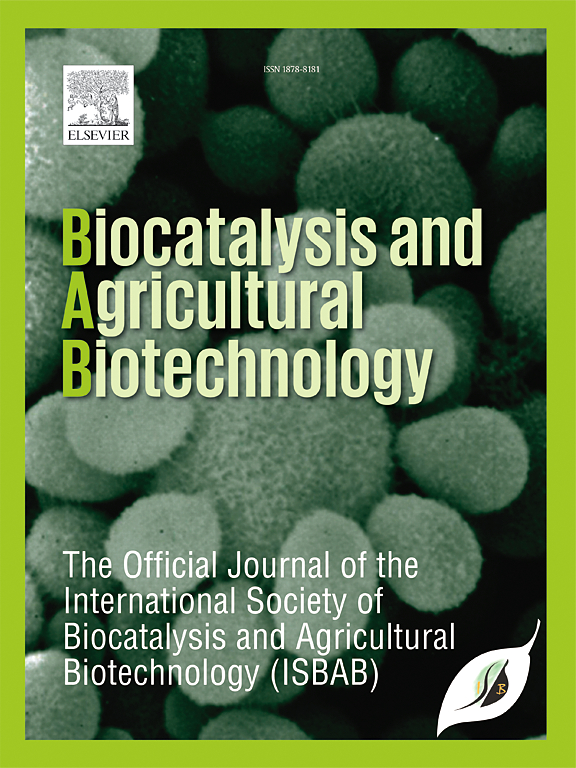Unveiling the effect of foliar applied siliceous compounds on reducing seed shattering for the conservation of endangered kalmegh (Andrographis paniculata (Burm. f.) wall. ex nees)
IF 3.8
Q2 BIOTECHNOLOGY & APPLIED MICROBIOLOGY
引用次数: 0
Abstract
This investigation was conducted to formulate a cost-efficient and dependable technique for the extensive regeneration of the Kalmegh plant, focusing on the challenge of seed shattering during the harvesting process. Across a biennial time frame spanning from 2022 to 2023, diverse siliceous substances were administered through foliar application to address seed-shattering issues and enhance growth parameters. The study was carried out utilizing a Randomized Complete Block Design (RCBD) involving seven treatments and 3 replications. The experimental site is situated in a semi-arid sub-tropical region known for hot summers and comparatively mild winters. Results revealed that the foliar application of potassium silicate at a concentration of 200 mg/L notably boosted plant height (42.86 cm), plant spread (19.68 cm2), root length (14.87 cm), and leaf dimensions (4.51 cm) compared to alternative treatments. Furthermore, the application of potassium silicate at 200 mg/L substantially decreased the number of shattered pods (262), while elevating the count of intact pods (91.23), overall pod tally (524.3), and seeds per plant (4718). Increased silicon levels were detected in capsules, suggesting a heightened silicon deposition in plant tissues after the utilization of siliceous substances. Principal component analysis and correlation assessments were utilized to evaluate the impacts of treatments and the interrelationships among variables. To distinguish treatment variations, PCA was performed on a total of eight parameters and six treatments. Together, PC-1 and PC-2 explained 96.14 % of the variance, with PC-1 accounting for 88.83 % and PC-2 for 7.31 %. Plant height is separated by PC-1; T2 shows negative loading, but the other variables and treatments show positive loading. The number of shattered seeds/pod is the main determinant of PC-2; T7 exhibits negative loading, whilst other seeds show positive loading. The links between shattered and unshattered pods, as well as other variables including plant height, plant spread, leaf size, and root length, regarding the use of siliceous compounds were investigated using correlation analysis. The study highlights the effectiveness of applying siliceous compounds via foliar approaches to augment Kalmegh seed productivity and growth attributes in an environmentally sustainable manner, thereby aiding in meeting the escalating demand for this significant medicinal plant.

揭示叶面施用硅质化合物对保护濒危山楂(穿心莲)减少种子破碎的作用。f。)。交货需要雇)
这项调查是为了制定一个具有成本效益和可靠的技术,用于卡尔梅植物的广泛再生,重点是在收获过程中种子破碎的挑战。在2022年至2023年的两年时间框架内,通过叶面施用多种硅质物质,以解决种子碎裂问题并提高生长参数。本研究采用随机完全区组设计(RCBD),包括7个治疗和3个重复。实验地点位于半干旱的亚热带地区,夏季炎热,冬季相对温和。结果表明,与其他处理相比,200 mg/L硅酸钾叶面处理显著提高了水稻株高(42.86 cm)、株展(19.68 cm2)、根长(14.87 cm)和叶片尺寸(4.51 cm)。此外,施用200 mg/L硅酸钾显著降低了碎荚数(262),同时提高了完整荚数(91.23)、总荚数(524.3)和单株种子数(4718)。在胶囊中检测到硅含量增加,表明利用硅质物质后植物组织中的硅沉积增加。采用主成分分析和相关评价来评价处理的影响和变量之间的相互关系。为了区分治疗变化,我们对8个参数和6种治疗方法进行了PCA。PC-1和PC-2共同解释了96.14%的方差,其中PC-1占88.83%,PC-2占7.31%。株高由PC-1分隔;T2表现为负负荷,而其他变量和处理表现为正负荷。粉碎种子/荚果数是PC-2的主要决定因素;T7为负负荷,其他种子为正负荷。利用相关分析方法,研究了硅质化合物使用对粉碎荚果和未粉碎荚果以及株高、株展、叶大小和根长等其他变量的影响。该研究强调了通过叶面方法应用硅质化合物以环境可持续的方式提高卡尔梅种子生产力和生长属性的有效性,从而有助于满足对这种重要药用植物不断增长的需求。
本文章由计算机程序翻译,如有差异,请以英文原文为准。
求助全文
约1分钟内获得全文
求助全文
来源期刊

Biocatalysis and agricultural biotechnology
Agricultural and Biological Sciences-Agronomy and Crop Science
CiteScore
7.70
自引率
2.50%
发文量
308
审稿时长
48 days
期刊介绍:
Biocatalysis and Agricultural Biotechnology is the official journal of the International Society of Biocatalysis and Agricultural Biotechnology (ISBAB). The journal publishes high quality articles especially in the science and technology of biocatalysis, bioprocesses, agricultural biotechnology, biomedical biotechnology, and, if appropriate, from other related areas of biotechnology. The journal will publish peer-reviewed basic and applied research papers, authoritative reviews, and feature articles. The scope of the journal encompasses the research, industrial, and commercial aspects of biotechnology, including the areas of: biocatalysis; bioprocesses; food and agriculture; genetic engineering; molecular biology; healthcare and pharmaceuticals; biofuels; genomics; nanotechnology; environment and biodiversity; and bioremediation.
 求助内容:
求助内容: 应助结果提醒方式:
应助结果提醒方式:


